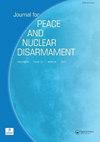Counterforce Dilemmas and the Risk of Nuclear War in East Asia
IF 1.4
Q4 INTERNATIONAL RELATIONS
引用次数: 0
Abstract
ABSTRACT The discovery of new Chinese nuclear missile silos, a seemingly escalating nuclear-conventional arms competition between the Democratic People’s Republic of Korea (DPRK) and the Republic of Korea (ROK), and the announcement that Australia, in concert with the United States and the United Kingdom, is pursuing nuclear-powered attack submarines are events that collectively indicate a worsening security environment in East Asia. Using geostrategic, operational, and technological factors as the basis for analysis, this paper contextualizes these and other developments and assesses the potential for nuclear war in East Asia in general and on the Korean Peninsula in particular. The most dangerous threat to strategic stability is a counterforce dilemma where the conventional weapons of the United States, China, and regional East Asian actors may create strategic instability by their intentional or inadvertent entanglement or use to target the nuclear forces of another state, resulting in pursuit of more secure second-strike capability by the countries of the region, and forming the heart of conventional warfighting and deterrence strategies. The many different conflictual or competitive relationships across the region make arms control initiatives unlikely to succeed, but the maritime nature of the geostrategic environment and the lack of existential threat that the United States and China pose to each other may offer fewer natural pathways to the use of nuclear weapons for either China or the United States than there were for the adversaries in the Cold War.东亚反作用力困境与核战争风险
中国新型核导弹发射井的发现,朝鲜民主主义人民共和国(DPRK)和大韩民国(ROK)之间的核常规军备竞赛似乎不断升级,以及澳大利亚宣布与美国和英国合作,正在寻求核动力攻击潜艇,这些事件共同表明东亚安全环境正在恶化。本文利用地缘战略、作战和技术因素作为分析的基础,将这些和其他发展置于背景下,并评估东亚特别是朝鲜半岛发生核战争的可能性。对战略稳定最危险的威胁是反作用力困境,即美国、中国和东亚地区行为体的常规武器可能会有意或无意地纠缠或用于瞄准另一个国家的核力量,从而造成战略不稳定,导致该地区国家追求更安全的二次打击能力,并形成常规战争和威慑战略的核心。该地区许多不同的冲突或竞争关系使军备控制倡议不太可能成功,但地缘战略环境的海洋性质以及美国和中国相互之间缺乏生存威胁,可能会为中国或美国提供更少的自然途径来使用核武器,而不是冷战时期的对手。
本文章由计算机程序翻译,如有差异,请以英文原文为准。
求助全文
约1分钟内获得全文
求助全文
来源期刊

Journal for Peace and Nuclear Disarmament
INTERNATIONAL RELATIONS-
CiteScore
1.30
自引率
0.00%
发文量
36
审稿时长
12 weeks
 求助内容:
求助内容: 应助结果提醒方式:
应助结果提醒方式:


